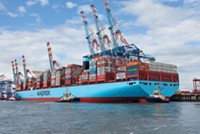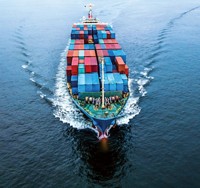Advertisement
Grab your lab coat. Let's get started
Welcome!
Welcome!
Create an account below to get 6 C&EN articles per month, receive newsletters and more - all free.
It seems this is your first time logging in online. Please enter the following information to continue.
As an ACS member you automatically get access to this site. All we need is few more details to create your reading experience.
Not you? Sign in with a different account.
Not you? Sign in with a different account.
ERROR 1
ERROR 1
ERROR 2
ERROR 2
ERROR 2
ERROR 2
ERROR 2
Password and Confirm password must match.
If you have an ACS member number, please enter it here so we can link this account to your membership. (optional)
ERROR 2
ACS values your privacy. By submitting your information, you are gaining access to C&EN and subscribing to our weekly newsletter. We use the information you provide to make your reading experience better, and we will never sell your data to third party members.
Business
Urea's Unlikely Role
Emissions reduction is new application for chemical best known as a fertilizer
by Michael McCoy
June 6, 2011
| A version of this story appeared in
Volume 89, Issue 23

The fastest-growing U.S. market for urea isn’t corn, wheat, or soybeans. It’s diesel trucks.
Urea is a nitrogen-containing compound that’s consumed by the silo-full in the Midwest as a fertilizer. It’s also used in industrial applications such as urea-formaldehyde resins and the manufacture of melamine.
But as of last year, urea has a new market in eliminating nitrogen oxides (NO x ) from truck engine exhaust through a process known as selective catalytic reduction, or SCR. For urea manufacturers, this new application is like manna from heaven. It won’t eclipse the fertilizer market, but it promises to be a stable, profitable outlet in a traditionally volatile industry.
A by-product of fuel combustion, NO x is a precursor to smog. In 2001, the Environmental Protection Agency issued new NO x limits for diesel engines, giving manufacturers a decade to come up with an approach that would be deployed in 2010. The three potential technologies that emerged in those early years were an exhaust gas recirculation technique, a zeolite-type catalytic converter called lean NO x trap, and urea-based SCR.
The chemistry of SCR is simple. A 32.5% by weight urea solution is injected into a vehicle’s hot exhaust gases, where the urea breaks down into ammonia. In the presence of a catalyst, the ammonia then reacts with nitrogen oxides and oxygen to form nitrogen gas and water.
But EPA officials warned that SCR was a long-shot candidate. It would require outfitting trucks with special tanks to hold the urea solution and creating a national infrastructure to distribute it. The trucking industry was likewise alarmed about the additional costs and complications of the SCR approach.
Nonetheless, by the fall of 2008, seven of the eight major U.S. diesel engine companies had chosen SCR. The eighth, Navistar, went with exhaust gas recirculation.
Tim Cheyne, director of emissions control at the London-based consulting firm Integer Research, says engine manufacturers in Japan and Europe, which preceded the U.S. in enacting stricter NO x regulations, also chose SCR after assessing similar options. “Despite resistance in all parts of the world, it’s always been where people ended up,” he says.
The beauty of the urea system, Cheyne explains, is that it eliminates the trade-offs engine designers traditionally faced between NO x creation, soot formation, and fuel efficiency. “Once you accept that you are going to bolt on a small chemistry unit to the exhaust system, you free yourself from the constraints of NO x emissions and can start optimizing the engine in a completely new way,” he says.
For truckers, that design freedom is translating into improvements in fuel efficiency of 4 to 8% over previous engines. Despite having to buy close to 10 gal of urea solution at $2.75 per gal each time they fill their fuel tanks, truckers are saving money. With a 5% fuel efficiency gain, Integer calculates, a driver can save $22,000 over a 10-year span.
Almost overnight, a new industry has sprung up to meet the emerging demand for the urea solution, which is known as DEF, for diesel exhaust fluid. Big truck stops such as Pilot and Flying J are installing DEF pumps, and many more locations are stocking canisters or jugs of DEF. Urea producers, meanwhile, are establishing a supply chain to get DEF to truckers.
Yara International, a Norwegian company that calls itself the world’s top nitrogen fertilizer maker, emerged as the leader in the European DEF market. Working with the fuel distributor Mansfield Oil, it intends to replicate that success in the U.S., according to Chad Dombroski, director of the firm’s North American DEF business, which it calls Air1.
DEF is made by mixing high-purity urea with deionized water. It’s shipped in stainless steel tanks to prevent contamination that could foul the SCR catalyst. For the moment, Yara is supplying the U.S. with DEF from urea plants in Saskatchewan and overseas. The company says it plans to invest in more DEF capacity this year, likely in the U.S., to meet explosive demand growth as revamped trucks are sold.
CF Industries, the largest U.S. urea producer, is also getting into the act. It has built DEF facilities at fertilizer plants in Oklahoma, Mississippi, and Ontario and is constructing a fourth unit in Iowa. In a conference call with analysts last month, CF’s chief executive officer, Stephen R. Wilson, said his firm’s first-quarter DEF shipments were roughly six times what they were a year earlier thanks to growing sales of SCR-equipped trucks.
Only about 65,000 metric tons of DEF was sold in North America last year, Dombroski says. But by 2020, Integer forecasts, DEF sales in the region will approach 5 million metric tons per year, requiring more than 1.5 million metric tons of urea.
By then, according to Cheyne, SCR will be rolled out in new regions such as Brazil and China and new markets including off-road vehicles, trains, marine vessels, and passenger cars. “Almost anywhere diesel engines are used, you are going to see SCR,” he says.





Join the conversation
Contact the reporter
Submit a Letter to the Editor for publication
Engage with us on Twitter